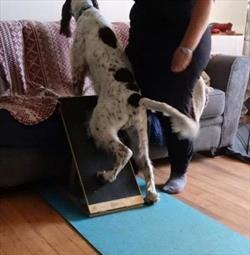Many dogs struggle with nail trims, so teaching a dog to use a nail board can reduce the stress of nail maintenance, and dogs will look forward to nail care. Teaching a dog to use the nail board for their hind feet is a separate action from the front feet and is taught as a separate exercise.
Steps:
To start, it can be helpful if your dog is already familiar with using a nail board for their front nails, but it is not necessary.
You will need an elevated platform large enough for your dog to stretch up and over the nail board so that the dog is almost in a standing position, a nail board of sufficient length for your dog so that when angled against the platform, your dog can raise their hind foot against it and scratch downwards, yummy treats, and a non-slip surface for the dog to stand on.
- If your dog is not familiar with a nail board, you can put it on the ground so that your dog can be free to explore it. You can place treats on the ground for your dog to sniff. Don’t force your dog to interact while they are getting used to it.
- Get your dog used to putting their front feet up on the raised surface without jumping all the way up. Show your dog a tasty treat and lure them up so their front feet are on the raised surface. As soon as they have their feet up, “click” or verbally mark “yes” and then give your dog the treat. When your dog is happy getting their front feet up, you can then introduce the nail board.
- Angle the nail board against your raised platform. Either hold on to it or secure it so that it doesn’t fall or move if your dog knocks it. You may need to adjust the angle to find the ideal angle for your dog.
- Lure or ask for a “paws up” onto the raised platform so your dog’s body is lined up over the nail board. If your dog is unsure, reward them if they reach up and put their front feet on the board, then increase the difficulty by luring them into having their front feet on the platform itself. With further repetitions, stretch the lure out further so your dog needs to stretch further.
- Your dog will move their back feet closer to reach the lure and will attempt to climb up. As soon as they move either foot closer to the scratchboard, click or say yes, and reward.
- After a few repetitions of marking any foot movement, stretch the lure a little further and wait for the dog to place their hind foot on the scratchboard itself. You can mark and reward both the foot on the nail board and again as the dog’s foot naturally starts to scratch downwards. With a few repetitions, you can transition to only rewarding the downward scratching movement.
Keep your sessions fun and short so your dog remains eager to participate in nail maintenance.





